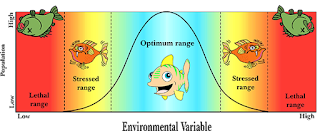Limiting Factors
• Condition is abiotic environmental factor that varies in space and time and affects the performance of organism. Example is temperature can affect the reproduction of organism because to matting and lay the egg, need a warm temperature.
• Resource is all things consumed (used up) by organisms (space, nutrients, water, prey, holes for refuge, etc) and its can devided into
Interactive resources. An organism does not need certain resources independently. For example, one that gets more heat might need more water, or less nitrogen.
Non-interactive resources. Independent resources that an organism needs. For example, a human being needs both iron and calcium, though ingesting one will not affect the need for the other.
• Resource is all things consumed (used up) by organisms (space, nutrients, water, prey, holes for refuge, etc) and its can devided into
Interactive resources. An organism does not need certain resources independently. For example, one that gets more heat might need more water, or less nitrogen.
Non-interactive resources. Independent resources that an organism needs. For example, a human being needs both iron and calcium, though ingesting one will not affect the need for the other.
Liebig’s law of the minimum: Growth of a plant is dependent on the amount of foodstuff which is presented to it in minimum quantity. This law of the minimum was first expressed by Justus Liebig in 1840. This law of the minimum is less applicable under ‘transientstate’ conditions when the amounts, and hence the effects, of many constituents are rapidly changing.
Shelfords’s law of tolerance: The existence, abundance, and distribution of a species in an ecosystem are determined by whether the levels of one or more physical or chemical factors fall within the range tolerated by that species. In other words, there are minimum and maximum limits for physical conditions (such as temperature) and concentrations of chemical substances-called tolerance limits-beyond which no members of a particular species can survive.
The degree of tolerance are (1) Steno is that has narrow range and (2) Eury is that has a comprehensive range

Limiting Factors are factor that is most deficient determine the presence or absence of any given organism. The presence and success of an organism or a group of organisms depends upon a complex of conditions. Any condition which approaches or exceeds the limits of tolerance is said to be a limiting condition or a limiting factor.

Physical Factors of Importance as Limiting Factors
TEMPERATURE:
1. Life can exist only within
-200deg to 100 deg C.
2. Most species are
restricted to a narrower
range of temperature
3. Aquatic organisms have
narrower range of
tolerance than
equivalent land animals
4. Organisms which are subjected to temperature variations tend to
be depressed, inhibited or slowed down by constant temperature

LIGHT:
The quality of light, the
intensity, and the duration
are known to be important
factors of light.
Both plants and animals
respond to different
quality of light.
Individual plants as well as
communities adapt to
different light intensities
by becoming ‘shadeadapted’.
Or ‘sun adapted’.

WATER:
Rainfall distribution over the year is an extremely important
limiting factor for organisms.
Humidity has a daily rhythm (high at night, low during the day),
and has special role in modifying the effects of temperature, hence
regulates the activities of organisms and in limiting their
distribution.
Evapo-transpiration is also an important limiting factor. Desert
plants expose only green buds or stems.
Dew , in areas of low rainfall, is a vital contributor to precipitation.
ATMOSPHERIC GASES:
The concentration of carbon di-oxide an oxygen is limiting to
many higher plants.
BIOGENIC SALTS (MACRONUTRIENTS & MICRONUTRIENTS:
Nitrogen and phosphorous salts are of major importance to
ecologists as limiting factors.
CURRENTS & PRESSURES
Currents in water not only influence the concentration of gases
and nutrients, but act directly as limiting factors.
Characteristics of ecological
indicators:
1. In general, steno species make much better indicators
than eury species.
Such species are often not the most abundant ones in the
community.
2. Large species usually make better indicators than small
species.
A large and more stable biomass and standing crop can be
supported with a given energy flow.
The turnover rate of small organisms may be so great that
the particular species present at any time may not be very
instructive as an ecological indicator
3. Before relying on as single species or groups of species as
indicators, there should be abundant field evidence.
4. Numerical relationships between species, populations, and
whole communities often provide more reliable indicators
than single species.
Source : Subodh Sharma Dr.nat.tech.; Aquatic Ecology Centre,


diberikan contoh nyata tentang perbedaan resource dan condition akan membuat pembaca lebih mengerti dan paham. gambar yang disesuaikan dengan topik juga dapat menamnah pemahaman pembaca. kemudian apa hubungan antara resource, condition dan limiting factors?
BalasHapusbukan hanya sekedar pengertian ya Aisya. saya sependapat dengan Dwi Darma untuk memberikan contoh riilnya seperti apa. Good job.
BalasHapussudah bagus, akan tetapi lebih baik jika ditambahkan gambar/ilustrasi dan juga sumber refrensi.. semangat..
BalasHapusDisertai contoh dan illustrasi gambar agar lebih jelas lagi. Semangat terus yaa
BalasHapusAkan lebih baik jika disertakan gambar hehe semangat
BalasHapus